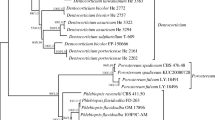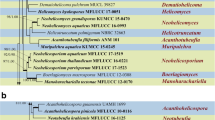Abstract
An 11 year study was conducted to reevaluate the species of stipitate hydnums from the southern United States especially the Great Smoky Mountains and surrounding geography. The genera evaluated included Bankera herein reduced to synonym with Phellodon, Hydnellum, Sarcodon, and Phellodon. Basidiomata of many stipitate hydnum species from this region were abundant but nitrogen depositions during the last 20 years have impacted their occurrences. Therefore it became critical to do a definitive study of these fungi using current taxonomic tools. Many species within Hydnellum and Phellodon have a indeterminate type growth often dependant on environmental conditions making discrimination between closely related species difficult without supportive molecular sequence data. Once sequence data (ITS) was obtained a phylogenetic analyzes were conducted and the sequences were compared to those in GenBank with particular attention to European data. A total of 41 distinct taxa were determined and many of those were confirmed based on morphological data. A specific new combination from Bankera fuligineoalbum to Phellodon fuligineoalbus is made herein. Futhermore, Phellodon brunneoolivaceus is described as new based on morphological and sequence data.















































Similar content being viewed by others
References
Ainsworth A (2011) Hydnellum cumulatum and H. gracilipes: two overlooked Scottish hydnoids new to Britain. Field Mycol 12:139–143
Ainsworth A, Parfitt B, Rogers H, Boddy L (2010) Cryptic taxa within European species of Hydnellum and Phellodon revealed by combined molecular and morphological analysis. Fungal Ecol 4:65–68. doi:10.1016/j.funeco.2009701
Baird RE (1986a) Studies of the stipitate hydnums from the southern Appalachian Mountains-Genera: Bankera, Hydnellum, Phellodon, Sarcodon. Bibl Mycol Cramer, Berlin-Stuttgart 104:156
Baird RE (1986b) Type studies of North American and other related taxa of stipitate hydnums: Genera: Bankera, Hydnellum, Phellodon, Sarcodon. Bibl Mycol Cramer, Berlin-Stuttgart 103:86
Baird RE (1987) Chemical constituents of the stipitate hydnums from the southern Appalachian Mountains. Mycotaxon 28:61–70
Baird RE (1988) Notes on the stipitate hydnums I. A new species of Phellodon. Nova Hedwigia 47:111–112
Baird RE, Khan S (1986) The stipitate hydnums (Thelephoraceae) of Florida. Brittonia 38:171–184
Banker HJ (1906) A contribution to a revision of the North American Hydnaceae. Mem Torrey Bot Club 12:99–124
Banker HJ (1913a) Type studies in the Hydnaceae III. The genus Sarcodon. Mycologia 5:12–17. doi:10.2307/3753221
Banker HJ (1913b) Type studies in the Hydnaceae IV. The genus Phellodon. Mycologia 5:62–66. doi:10.2307/3753564
Banker HJ (1913c) Type studies in the Hydnaceae V. The genus Hydnellum. Mycologia 5:194–205. doi:10.2307/3753385
Batsch C (1789) Elenchi Fungorum Continuatio Secunda 2:99–112
Binder M, Hibbett D, Larsson K-H, Larsson E, Langer E, Langer G (2005) The phylogenetic distribution of resupinate forms across the major clades of mushroom-forming fungi (Homobasidiomycetes). Syst Biodiv 3:113–157. doi:10.1017/S1477200001623
Bruns TD, White TJ, Taylor JW (1991) Fungal molecular systematics. Annu Rev Ecol Syst 22:525–564
Borneman J, Hartin RJ (2000) PCR primers that amplify fungal rRNA genes from environmental samples. Appl Environ Microbiol 66:4356–4436. doi:10.1128/AEM.66.1.4356-436.2000
Coker WC (1919) The Hydnaceae of North Carolina. J Elisha Mitch Sci Soc 34:163–197
Coker WC (1926) Further notes on hydnums. J Elisha Mitch Sci Soc 41:270–287
Coker WC (1927) New or noteworthy Basidiomycetes. J Elisha Mitch Sci Soc 43:129–131
Coker WC (1939) New or noteworthy Basidiomycetes. J Elisha Mitch Sci Soc 55:34–39
Coker WC (1942) Notes on rare hydnums. J Elisha Mitch Sci Soc 58:94–97
Coker WC, Beers AH (1951) The stipitate hydnums of the eastern United States. Univ. N. C. Press, Chapel Hill, p 211
Gärdenfors U (2005) Rödlistade arter i sverige. Swedish Species Information Centre, Uppsala
Gardes M, Bruns TD (1993) ITS primers with enhanced specificity for basidiomycetes-application to identification of mycorrhizae and rusts. Mol Ecol 2:113–118. doi:10.111/j.1365-294X.1993.tb00005
Grebenc T, Martin MP, Kraigher H (2009) Ribosomal ITS diversity among European species of the genus Hydnum (Hydnaceae). Anal del Jardin Botanic de Madrid 66S1:121–132. doi:10.3989/ajbm.2221
Hall DM, Stuntz DE (1972) Pileate Hydnaceae of the puget sound area. Brown spored genus Hydnellum. Mycologia 64:560–590. doi:10.2307/3757873
Harrison KA (1961) The stipitate hydnums of Nova Scotia. Can Dept Agr Publ. 1099. 60 pp. doi:10.5962/bhl.title.58911
Harrison KA (1964) New or little known North American stipitate hydnums. Can J Botany 42:1205–1233. doi:10.1139/b64-116
Harrison KA (1968) Studies of the hydnums of Michigan I. Genera Phellodon, Bankera, Hydnellum. Michigan Bot 7:212–264
Harrison KA (1972) A new species of Phellodon possessing clamp connections. Can J Botany 50:1219–1221
Harrison KA, Grund DW (1987a) Preliminary keys to the terrestrial stipitate hydnums of North America. Mycotaxon 28:419–426
Harrison KA, Grund DW (1987b) Differences in European and North American stipitate hydnums. Mycotaxon 28:427–435
Hillis DM, Dixon MT (1991) Ribosomal DNA: molecular evolution and phylogenetic inference. Q Rev Biol 66:411–45
Holmgren PK, Holmgren NH, Barnett LC (1990) Index herbariorum. Part I: the herbaria of the world. 8th ed. New York Botanical Gardens. p 693
Hughes KW, Petersen RH, Lickey EB (2009) Using heterozygosity to estimate a percent DNA sequence similarity for environmental species delimitation across basidiomycete fungi. New Phytol 182:795–798
Jones TH (1935) The Hydnaceae of Tennessee. Thesis, University of Tennessee. p 175
Katoh K, Kuma K, Toh H, Miyata T (2005) MAFFT version 5: improvement in accuracy of multiple sequence alignment. Nucleic Acids Res 33:511–518. doi:10.1093/nar/gki198
Kornerup A, Wanscher JH (1967) Methuen handbook of colour, 2nd edn. Methuen Co., London, p 243
Lloyd CG (1916) Mycological notes. p 552
Maas Geeseranus RA (1962) Hyphal structures in the hydnums. Persoonia 2:476
Maas Geesteranus RA (1958) The stipitate hydnums of the Netherlands. Fungus 28:48–61
Maas Geesteranus RA (1960) Notes on the hydnums. Persoonia 1:341–384
Maas Geesteranus RA (1963) Hyphal structures. III. Proc Kon Ned Akad Wet (Ser C) 66:437–446
Maas Geesteranus RA (1964) The Hydnellum aurantiacum complex. Proc Kon Ned Akad Wet (Ser C) 44:144–156
Maas Geesteranus RA (1967) Notes on hydnums. Proc Kon Ned Akad Wet (Ser C) 70:50–72
Maas Geesteranus RA (1971) Hydnaceous fungi of the eastern old world. Verh Kon Ned Akad Wet (Ser 2) 60:176
Maas Geesteranus RA (1974) A brief article: a response to K. A. Harrison. Mycologia 66:868–876
Maas Geesteranus RA (1975) The terrestrial hydnums of Europe. Verh Kon Ned Akad Wet, Afd Natuurk, Tweede Reeks 65:127
Mata JL, Hughes K, Petersen RH (2007) An investigation of Omphalotaceae (Fungi: Euagarics) with emphasis on the genus Gymnopus. Syndowia 58:191–289
Nikolaeva TA (1977) Hydnaceous fungi. Cryptogameous plants of the USSR. 6:p 578
O’Brien HE, Parrent JL, Jackson JA, Moncalvo JM, Vilgalys R (2005) Fungal community analysis by large-scale sequencing of environmental samples. Appl Environ Microbiol 71:5544–555. doi:10.1128/AEM.71.9.5544-555.2005
Parfitt D, Ainsworth AM, Simpson D, Rogers HJ, Boddy L (2007) Molecular and morphological discrimination of stipitate hydnoids in the genera Hydnellum and Phellodon. Mycol Res 111:761–777. doi:10.1016/j.mycrres.2007503
Petersen RH (1976) The southern Appalachian Mountains as a refugium for tropical Basidiomycetes. In: Parker BC, Roane MK (eds) Distributional history of the biota of the Southern Appalachians Part IV. ALGAE AND FUNGI. Univ. Press of Virginia, Charlottesville, pp 287–295
Petersen RH, Hughes KW (2010) The Xerula/Oudemansiella complex (Agaricales). Nova Hedwigia Beiheft, vol 137. J. Cramer, Stuttgart, p 625
Posada D (2008) jModelTest: phylogenetic model averaging. Mol Biol Evol 25:1253. doi:10.1093/molbev/msn083
Ronquist F, Huelsenbeck JP (2003) MRBAYES 3: Bayesian phylogenetic inference under mixed models. Bioinformatics 19:1572–1574. doi:10.1093/bioinformatics/btg180
Smith SE, Read DJ (2008) Mycorrhizal symbiosis, 3rd edn. Academic, London, 800 pp
Snell WH, Dick EA, Jackson HAC (1956) Notes on the pileate hydnums. III. Lloydia 19:163–175
Trudell SA, Edmonds RL (2004) Macrofungus communities correlate with moisture and nitrogen abundance in two old growth conifer forests, Olympic National Park, Washington, USA. Can J Botany 82:781–800. doi:10.1139/b04-057
Van Der Linde S, Alexander IJ, Anderson IC (2008) A PCR-based method for detecting the mycelia of stipitate hydnoid fungi in soil. J Microbiol Meth 75:40–46. doi:10.1016/j.mimet.20084010
Van Der Linde S, Alexander IJ, Anderson IC (2009) Spatial distribution of sporocarps of stipitate hynoid fungi and their belowground mycelium. FEMS Microbial Ecol 69:344–52. doi:10.1111/j.1574-6941.20090716.x
Vesterholt J, Asman WAH, Christensen M (2000) Kvaelstofnedfald og tilbagegang for svampe på mager bund. Svampe 42:53–60
Vilgalys R, Hester M (1990) Rapid genetic identification and mapping of enzymatically amplified ribosomal DNA from several Cryptococcus species. J Bacteriol 172:4238–4246
Walker JF, Miller OK Jr, Horton JL (2008) Seasonal dynamics of ectomycorrhizal fungus assemblages on oak seedlings in the southeastern Appalachian Mountains. Mycorrhiza 18:123–132. doi:10.1007/s00572-008-0163-8
Westmoreland S (2003) Morphological and olecular studies of Hydnellum (Basidiomycota, Thelephoraceae), reinforced with a new method, chemosystematics with HPLC using mass spectrometry (CHUMS). Thesis, University of Wisconsin-La Crosse, La Crosse, WI. p 212
White TJT, Bruns T, Lee S, Taylor J (1990) Amplification and direct sequencing of fungal ribosomal RNA genes for phylogenetics. In: Innis MA, Gelford DH, Sninsky JJ, White TJ (eds) PCR protocols, a guide to methods and applications. Acad. Press, San Diego, pp 315–322
Acknowledgments
Thanks are due to Drs. Larry Grand, NCSU, and Ron Petersen, TENN, for providing their advice and numerous collections of stipitate hydnums to enable completion of the study. Dr. Roy Halling and staff at NYBG supplyied photocopies of research materials from earlier studies on the stipitate hydnums. Special thanks go to Allein Stanley, Jay Justice and Andy Methven for their positive support and David Pratt, Facilities Manager, University of Tennesse Field Biology Station, for housing and laboratory use during the project.
Funding to cover the costs for travel throughout the Blue Ridge Province and surrounding areas was provided by numerous supplemental grants. The Highlands Biological Station granting program partially supported travel and housing expenses in the 2004 and 2005 growing seasons. Lexemual and Ester Hesler Visiting Professors Endowment Fund travel fund supported the work in 2006. All other funds to cover expenses for molecular sequencing were internal support through the Mississippi State University, Department of Entomology and Plant Pathology (MAFES Experiment Station Number 12185). A special thanks is due to Dr. Clarence Collison, chairman of that department (retired), who strongly supported efforts to continue on with the monograph until published even with limited funding. Katherine (Kat) Lawrence for making and revising the photographic plates and general support of the document.
Appreciation is extended to all the amateur mycologists and foray participants (Wildacres, NC forays) who gave us many important collections of stipitate hydnums and occasionally very rare ones. Special thanks to Todd Elliot who seemed to find rare species on every occasion we attended forays together. To the laboratory personnel, especially Candace Parker, for her/their molecular sequence support and to Paul Scott, who provided all the light microscopic photographs shown in this document.
Author information
Authors and Affiliations
Corresponding author
Rights and permissions
About this article
Cite this article
Baird, R., Wallace, L.E., Baker, G. et al. Stipitate hydnoid fungi of the temperate southeastern United States. Fungal Diversity 62, 41–114 (2013). https://doi.org/10.1007/s13225-013-0261-6
Received:
Accepted:
Published:
Issue Date:
DOI: https://doi.org/10.1007/s13225-013-0261-6




